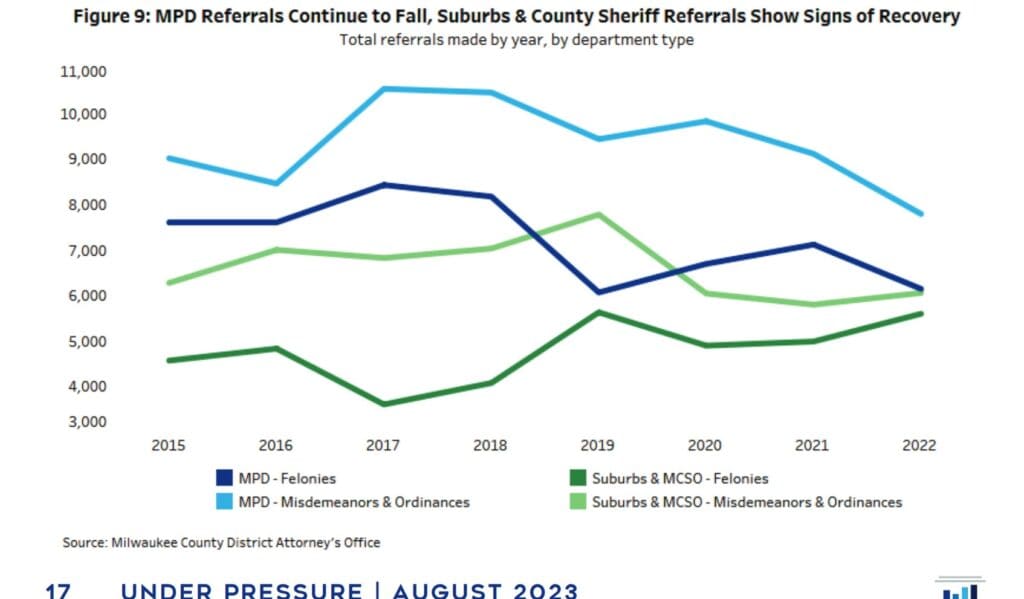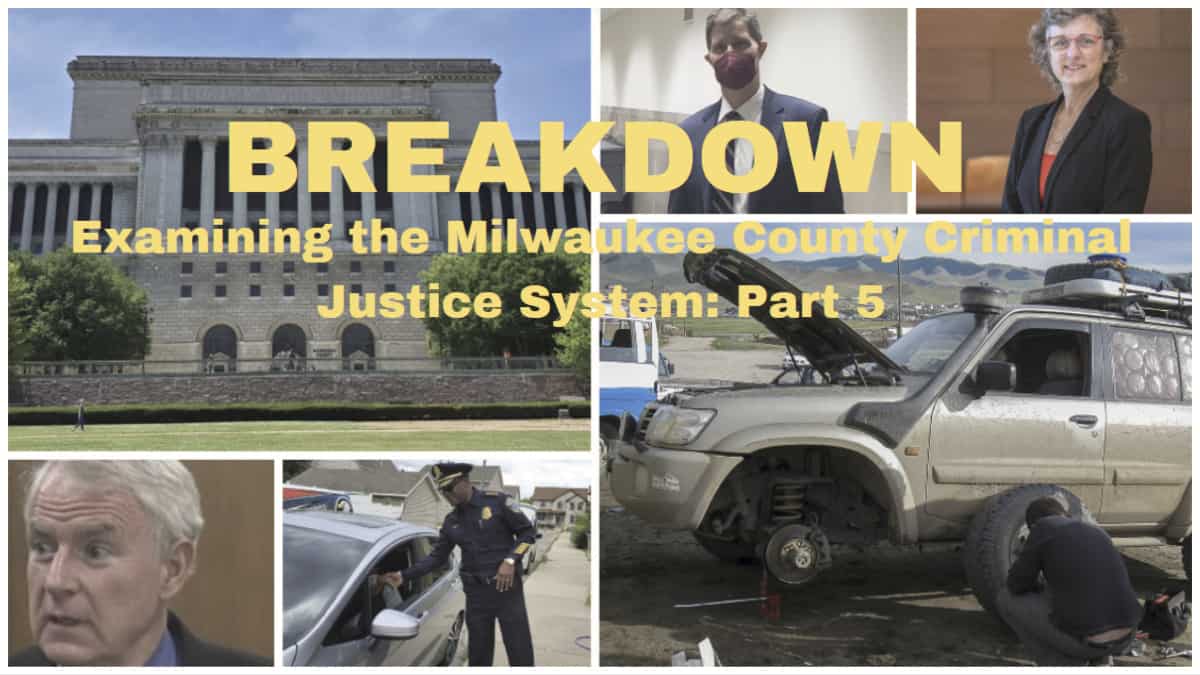PART FIVE IN AN 11-PART SERIES. Reads parts 1, 2, 3, and 4.
Milwaukee County’s criminal justice system has broken down at almost all levels.
Although some of the breakdown can be attributed to the pandemic, some can not. Local officials’ questionable policy decisions also play a role, and it’s imperiling public safety. The pandemic exacerbated some already existing trends and caused others, but officials have not developed effective strategies to recover. Some non-pandemic-related issues, like the ACLU-related Collins Agreement’s impact on proactive policing and plummeting numbers of police officers (down 26% since 1996) have been largely overlooked in the media.
PROBLEM #5: The number of criminal charges issued by the Milwaukee DA’s office has plummeted since 2018. [For a recent example, read about this stolen car out of River Hills.] This is partly explained by a drop in police arrests and referrals but not entirely.
That’s because the percentage of cases charged also dropped, with 2022 being the lowest ever. In a series we wrote about this issue in 2021, we call it the DA’s non-prosecution rate. But the numbers are even worse in 2022. They are particularly bad for domestic violence cases.
“The charge rate for domestic violence referrals declined each year, falling from 31.8% to 18.8% over the four-year period” through 2022. Suspects were taken into custody at the scene in fewer referred domestic violence cases.

The DA used to charge more than 45% of both felonies and misdemeanor cases referred by police. The misdemeanor charging rate plunged to a low of 34.4% in 2022. The felony charge rate dropped to a low of 39.7% in 2022, the report said.

Put another way: That means that DA John Chisholm’s office is refusing to charge more than 65% of misdemeanor cases and more than 60% of felony cases brought over by police agencies.

Furthermore, the pandemic has not affected police referrals to the DA “in a significant way.” However, since 2018, before the pandemic, Milwaukee County police agencies have referred far fewer misdemeanor cases to the DA. Suburban agency referrals are now growing, whereas MPD’s keep dropping.
 THE SERIES:
THE SERIES:
We have taken the lead in exploring the problems in Milwaukee County’s Criminal Justice system since our site launched in 2020, breaking stories on Milwaukee police staffing declines (which started years ago), the DA’s high non-prosecution rate and new reliance on summonses, the 2018 ACLU Collins Agreement’s deleterious effect on proactive policing, new jail and police policies restricting bookings and arrests, and the massive court backlogs, which leave defendants on the streets longer to re-offend and provoke constitutional concerns. Milwaukee is at a crisis point, with record homicide numbers and a severe reckless driving crisis.
Now, a new August 2023 report from the Wisconsin Policy Forum has examined Milwaukee County’s Criminal Justice System in great detail, providing fresh data from 2018 (before the pandemic) to 2022. We are excerpting some of the key statistical findings in our 11-part series to further understanding of the problem. You can’t formulate solutions if you don’t understand the problem’s scope. The few news articles that emerged only superficially skimmed over the report’s findings. The report’s authors are Rob Henken, Ari Brown, and Betsy Mueller.
Although the report deals with the context of the pandemic, it also makes it clear that, in some respects, trends imperiling public safety started before it or have continued, even escalating in some cases, in 2022, after its height. In other words, you can’t blame everything on the pandemic. The report also indicates that, in a number of ways, some problems that escalated during the pandemic have not been resolved by officials even as late as 2022. In other cases, progress has been made.
“Overall, this report has revealed that multiple key points of the justice system pipeline in Milwaukee County are not functioning in the same way or at the same level as they were prior to the pandemic,” the authors wrote. “It is now incumbent upon justice system leaders and state and local policymakers to aggressively explore why that is, to what degree it may have impacted public safety, what progress is being made in remedying the identified challenges, and whether additional resources or other solutions are required to get the system back on track.”
In each article, which we will run over the next 11 days at 7 a.m. every day, we will outline the problems and present the research. After that, we will run a wrap-up article suggesting solutions. What happens in the state’s largest county has an effect throughout Wisconsin. The WPF report was commissioned by the Milwaukee-based Argosy Foundation and the Milwaukee Community Justice Council (CJC). Most of it is focused on useful data. In cases where we think aspects were left out, we will note that. In this series, we hope to get past simplistic rhetoric (“it’s the state Legislature’s fault!” on the left or “who cares what happens in Milwaukee!” on the right.)
PROBLEM #5
Milwaukee County District Attorney John Chisholm’s charging rate has plummeted. The report’s authors asked Chisholm’s office for an explanation. The DA’s office:
- “DA officials note that MPD plays a critical role in charging decisions, as thorough police work provides the evidence needed to reliably charge alleged offenders. They suggest that first the turmoil caused by the pandemic, and then the limitations on officers’ time to conduct investigatory work and supply prosecutors with needed evidence, may have impacted the ability of prosecutors to pursue charges.” [Our note: In other words, they tried to pass the buck to police.]
- They also cited staffing levels in the district attorney’s office. “There have been four years since 2000 in which at least 18 of the Milwaukee County DA office’s nearly 120 attorney positions (15%) have turned over, with three of those (2017, 2019, 2022) coming in the last six years. In fact, while the office averaged 8.0 separations per year from 2000 to 2005, that almost doubled to 15.2 from 2018 to 2022. Officials from the office note that new prosecutors generally enter with little background in the field and may be more reluctant to pursue charges than veteran prosecutors.”
- A final explanation involves pandemic “precipitated changes in domestic violence-related prosecutions. Officials from the DA’s office point to a substantial drop in the charge rate for such cases, which contributes substantially to the drop in overall charge rates. They attribute the decline – in large measure – to the greater difficulty the office experienced in communicating with and obtaining cooperation from victims and witnesses during the height of the pandemic and the lingering aspect of that phenomenon to this day.” There is a decline in domestic violence victims seeking assistance from community organizations.
- “DA office officials note that there has been a decline in the percentage of domestic violence cases that are referred to the office in which the suspect has been arrested at the scene of the incident and is considered in custody. Whereas that percentage ranged between 44% to 46% in 2019 and 2020, it dropped to about 40% in 2021 and 2022. Officials say the lower percentage of cases in which the suspect is in custody may be contributing to lower charge rates given that when the suspect is not in custody it can be more difficult to prove the identification of the alleged offender and obtain any admission regarding conduct.”
The report found:
- For both felonies and misdemeanors, in each year between 2015 and 2019, the DA’s charge rate “was above 45%. Since 2020, there has yet to be a year in which the misdemeanor charge rate has been above 37.2%, and it fell to a low of 34.4%
in 2022.” - “Felony charge rates also have seen a drop-off, from a peak of 48.9% in 2017 to 44.1% in 2020, 41.6% in 2021, and a low of 39.7% in 2022,” the report said.
- “In 2022, the DA issued 2,127 felony charges and 1,938 misdemeanor charges related to MPD referrals. Those charge numbers were 18.4% lower for felonies and 40.8% lower for misdemeanors than in 2019.”
- “For charges related to referrals from all non-MPD agencies, misdemeanor charges show a similar trend. The DA issued 2,198 misdemeanor charges for cases referred from those agencies in 2022, a decline of 38.7% from 2019.”
- “However, felony charges have trended dissimilarly with regard to cases referred from the 20 non-MPD agencies relative to MPD: while 2022 felony charges (2,534) were below 2019 numbers (3,014), they were higher than total charges in 2020, 2021, and each year of data available prior to 2019. Also, there were fewer felony charges from cases referred by the non- MPD departments in 2020 and 2021 than in 2019, but numbers since the pandemic were still above levels from 2015 to 2018.”
The number of charges for cases referred by police has plummeted.
- “Total charges for cases referred from all Milwaukee County law enforcement agencies peaked in 2018, at 14,916 charges issued. That represented at least the fourth straight year of increases. Charges dropped slightly to 14,507 in 2019 and then fell significantly in 2020 to 11,855. They have dropped in both years since, to 11,357 in 2021 and 10,593 in 2022.”
Milwaukee County police agencies, including MPD, refer charges to the DA’s office, which decides whether to issue them.
Referrals to the DA

- The report found that referrals are down since 2018, but this is not likely due to the pandemic “in a significant way.” However, Milwaukee County police agencies are referring fewer misdemeanors to the DA.
- “Overall, referrals appear not to have been impacted immediately by the pandemic in a significant way, as more individuals were referred in 2020 (27,509) than in 2015 (27,493),” the report says. “Still, overall numbers are down from a peak in 2018 (29,786), and have now dropped in four consecutive years, reaching a low of 25,642 by 2022 (-13.9% from 2018).”
- “After peaking in 2017 at 15,537, referrals from all Milwaukee County law enforcement agencies for misdemeanors dropped in each of the next five years. Felony referrals stayed consistent, never going above 12,500 or below 11,500.”
- “While non-MPD agencies made fewer referrals in 2020 (10,963) and 2021 (10,823) than in 2019 (13,432), their 2022 numbers grew to 11,676. However, as shown in Figure 9, MPD referrals in 2022 dropped to their lowest level in the available data (13,966).”
Table of Contents





![Mandela Barnes Said ‘Reducing Prison Populations is Now Sexy’ [VIDEO] Reducing Prison Populations is Now Sexy](https://www.wisconsinrightnow.com/wp-content/uploads/2022/09/Collage-Maker-14-Sep-2022-11.44-AM-265x198.jpg)






